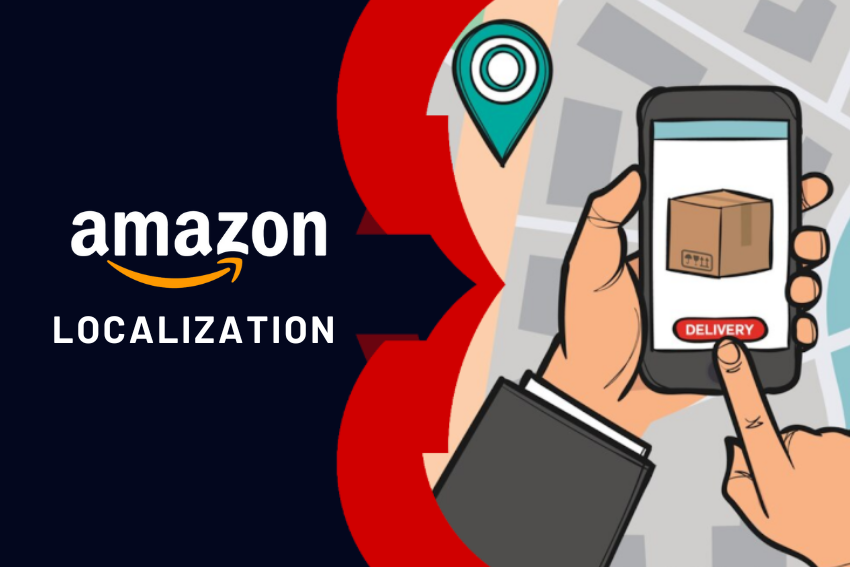As the fast-growing market in e-commerce business, Amazon has been delved to overcome geographical as well as cultural barriers in the international markets. Its localization strategy helps Amazon to adapt services, products, and customers’ experiences based on the premises of each country and culture to ensure the company reaches unprecedented success around the world.
- There are 21 international marketplaces on Amazon, including a newly launched platform in South Africa as of May 2024. [Source]
- Amazon’s international platforms attract significant traffic. For instance, Amazon.ca (Canada-specific marketplace) in October 2024 recorded almost 234.4 million visitors per month [Source], while Amazon.com.mx in Mexico sees about 169.5 million monthly visitors [Source]
- In the third quarter of 2024, Amazon’s international sales reached $158.9 billion, marking an 11% year-over-year increase from $143.1 billion [Source]
The above-mentioned data clearly illustrates that Amazon is increasingly focusing on expanding its operations globally, giving sellers more opportunities to reach a wider user base through localization. However, selling globally on Amazon is not as simple as sellers think. Without effective localization strategies, you can fail miserably, and Amazon is a prime example of that. Amazon’s global expansion strategy failed for China as they tried to implement the same model there as they did in the USA [Source]. To build a strong presence on Amazon’s international marketplaces, you need effective localization strategies.

Join us as we list down the best Amazon product localization strategies (that go far beyond listing products and translation) and seize the growth opportunities these various marketplaces have to offer.
How Localization Needs Vary for Various Countries
On different Amazon marketplaces, the need for localization differs, and a one-size-fits-all approach simply won’t work. Hence, when optimizing product listings effectively for a specific marketplace, it becomes critical to first identify and prioritize the key localization factors unique to that region.
Here, we explain to you in detail how localization needs vary for different Amazon marketplaces, so you must remain mindful of this when selling globally on Amazon.
| Marketplace | Primary Language & Translation Needs | Top-Selling Categories | Regulatory Challenges | Cultural Preferences |
|---|---|---|---|---|
| United States | Simple English, Persuasive tone | Electronics, Fashion, Home & Kitchen | Product safety certifications and sales tax compliance across states | Focus on convenience and premium quality. High demand for fast shipping |
| Germany | High-quality German translation | Electronics, Books, Home | Stringent packaging and environmental labeling requirements | Preference for eco-friendly products and high-quality engineering |
| Japan | Polished, contextually adapted Japanese | Electronics, Toys, Beauty Products | Import/export documentation, safety certifications specific to Japan | Strong emphasis on technology and compact design. Aesthetics matter. |
| India | Hindi and English, mixed as appropriate | Mobile Phones, Electronics, Fashion | GST compliance, regional language support in packaging and labeling | Price-sensitive, high demand for value-for-money products |
| United Kingdom | Polished British English | Books, Fashion, Electronics | Compliance with UKCA markings and sustainability laws post-Brexit | Key considerations involve sustainability and ethical sourcing |
Benefits of Amazon Localization – Why You Should Consider It
Before jumping straight to the best Amazon localization strategies, let’s first understand the key advantages of expanding your business globally on this leading platform:
1. Less Competition, More Chances of Visibility
Global expansion on Amazon is a great option when you are struggling to get the desired visibility and traction in a saturated marketplace. Let’s understand this through an example of camping stoves:
On Amazon.com, there are only 752 listings of camping stoves:

While on Amazon.co.uk, you can see over 9000 listings for camp stoves:

On Amazon.ca, this number is even higher, showing over 40,000 listings:

Since there are only 752 listings available on Amazon.com for camping stoves, sellers have less competition in that marketplace and, hence, more chances to get better sales with competitive pricing.
2. Reduced Vulnerability to Local Economic Fluctuations
Global expansion on Amazon allows you to reduce your reliance on the economy of a single region. If one market faces a slowdown, demand in other regions can help balance things out, keeping your revenue steady.
For example, if inflation affects sales in the U.S., sellers with localized listings in countries like Germany or Japan may still see stable or even growing demand. This diversity ensures your business is better protected from regional economic ups and downs.
3. Lower Customer Acquisition Costs in Emerging Markets
Emerging markets like India, Brazil, and Southeast Asia often have fewer sellers competing for attention, leading to reduced advertising costs. Data shows that CPC cost is significantly lower in these countries than in the US.
By localizing your listings for these markets, you can capitalize on lower ad costs while reaching a growing base of first-time eCommerce shoppers who are more likely to convert due to a lack of alternatives.
4. Early Mover Advantage in Emerging eCommerce Markets
In less mature regions, sellers who localize early can establish themselves as trusted brands before competitors flood the market. For instance, Amazon’s Sweden, Netherlands, Poland, and Belgium marketplaces are still catching up as compared to its USA, Canada, and Mexico marketplaces. By localizing for such regions, you can capture market share early, building customer loyalty and enjoying long-term dominance while competitors scramble to catch up.
5. Multiple Revenue Channels
One of the biggest benefits of Amazon localization is that it opens up multiple revenue streams for you. For example, a seller who lists eco-friendly products on Amazon Germany might find significant traction due to the high demand for sustainable goods in that market, even if the same products perform moderately in the U.S. Additionally, localized listings can lead to increased revenue through participation in region-specific events like Prime Big Deal Days on Amazon US or Great Indian Festival on Amazon India, which aren’t available in every marketplace.
6. Improved Brand Equity and Global Perception
Several studies conducted in the past clearly highlight that over 70% of shoppers prefer to shop for products in their native language. Hence, when you localize listings on Amazon for diverse languages and cultural nuances, you boost your brand’s credibility and global perception. A well-localized brand is often perceived as more professional and reliable.
Techniques and Best Practices for Amazon Localization
1. Use Data-Driven Analytics to Tailor your Localization Efforts
Data is your best friend when localizing for different Amazon marketplaces. By analyzing sales trends, shoppers’ preferences, and search behavior in particular regions, you can optimize your listings for better reach. You can use tools like Amazon Brand Analytics or third-party platforms such as Helium 10, Jungle Scout, and DataHawk to find high-performing keywords, seasonal trends, and bestselling products in specific markets.
For example, if the data shows eco-friendly products are gaining traction in the USA, update your listings to emphasize sustainable features. By tailoring your approach based on real insights, you can make your products more appealing to local shoppers and improve your chances of success.
2. Perform Competitive Analysis
Amazon localization strategies vary significantly from one marketplace to another. What works for you in one marketplace may not work on another marketplace. To be on the safe side, you must check what your competitors are doing to succeed.
Identify your top-performing competitor on a targeted marketplace, analyze their listings (prices, descriptions, discount offers, and other elements), and optimize your product pages accordingly. If competitors in a specific market overlook customer concerns like extended warranties, emphasizing that in your listings could give you an edge. To get detailed insights on competitors, use tools like AMZScout, SellerApp, and Keepa.
3. Hyper-Personalization through AI and Machine Learning
Use AI-driven tools to localize Amazon listings at scale. There are platforms like Algolia, Dynamic Yield, or Bluecore that can help optimize content based on local preferences. Utilizing machine learning algorithms, these tools can predict purchasing behaviors, allowing you to tailor product recommendations for specific regions.
4. Leverage Dynamic Pricing Strategies for Different Markets
Not every market reacts the same way to pricing. For example, as per an Amazon seller, shoppers in Spain or Italy are willing to pay more than those in the UK. Hence, the sellers adjust their prices dynamically for different regions.
Competition also plays a crucial role in deciding pricing for different marketplaces. On some Amazon marketplaces, the competition can be low, and thus, you can keep product pricing a bit higher, while on some marketplaces, the competition can be high. Thus, sellers are advised to keep the pricing lower for better visibility.
5. Optimize for Local SEO and Voice Search
Localization doesn’t stop at translating keywords—it’s about using terms that local shoppers actually search for.
In different countries, people use different phrases for the same product. For example, in the U.S., to search for a vacuum cleaner, shoppers might use phrases like “cordless vacuum” or “handheld vacuum,” while in the UK, they are more likely to use terms like “hoover” or “bagless hoover.” Hence, when localizing Amazon listings for a particular region, it is crucial to optimize the key terms accordingly in the title and description for better visibility.
Also, with the rise of voice shopping, ensure your product titles and descriptions include conversational phrases. For example, instead of just “portable charger,” you might include “best power bank for travel” for regions where voice search is popular.
6. Include Local Currency/Payment Methods
Research reveals that majority of shoppers are more likely to trust and complete purchases when they can pay in their local currency using familiar/preferred payment methods. Hence, to reduce the abandoned cart rates, Amazon sellers must include popular payment methods or local currency options.
Tools like Payoneer, WorldFirst, or PingPong Payments can help sellers manage local currency payouts and enable preferred payment methods. Ensure the displayed prices reflect the local currency to avoid any confusion during checkout.
7. Adapt Brand Messaging according to Cultural Sensitivity
As we saw in the comparison table (showcased in a previous section of this blog), cultural preferences vary for different Amazon marketplaces, and adapting your branding strategy according to cultural diversity becomes crucial to align with local values. Here is an example of an Adidas brand store on Amazon’s different marketplaces. See how their graphics and layout vary for two prominent marketplaces, i.e., Amazon.co.uk and Amazon.in.
Adidas UK store

Adidas Indian store

Depending on users’ preferences, behavior, and shopping patterns, Adidas has adapted two different approaches to showcase its product on these two marketplaces.
8. Be Mindful of Government Regulations and Shopping Holidays
Every region has its own set of shopping holidays that can significantly influence sales, and targeting these events with localized strategies is essential. For example:
- United States: In the US, some popular shopping events are Black Friday, Cyber Monday, and Prime Day. Since Black Friday comes after Thanksgiving, it is one of the biggest shopping days for US shoppers, they expect heavy discounts on all items. For this market, sellers need to plan inventory months in advance and ramp up advertising for these high-volume sales events.
- United Kingdom: In contrast, while the UK also participates in Black Friday and Cyber Monday, events like Boxing Day Sales (December 26) are equally critical. Since the event falls after Christmas, shoppers expect heavy discounts, particularly on fashion and household goods.
Things to Consider Effectively Hyper-Localize Amazon Product Listings
1. Carefully Study Shipping Costs and Times
Shipping costs, time, and policies differ significantly for different Amazon marketplaces. Additionally, on some marketplaces, unexpected expenses like custom duty or region-specific logistics fees can reduce your profit margins if you have not considered them in advance.
Hence, it is necessary to first understand Amazon’s international shipping terms and conditions. Also, to save more on profit margins, you can consider more affordable shipping options such as Amazon’s FBA service. By providing better shipping at a low cost, you can boost your seller’s rating on the platform.
2. Don’t Neglect Local Competition
Another mistake you should avoid when selling globally on Amazon is to underestimate local competitors. On every Amazon marketplace, there are some established local sellers who deeply understand their audience and provide them with rich shopping experiences. If you fail to analyze and differentiate yourself, your products may get buried under a sea of better-optimized listings.
3. Don’t Rely Solely on Automated Translations
Automated translation tools might seem convenient, but they have limited (often negligible) cultural context and often lead to mistranslation. A literal translation can result in inappropriate phrasing, miscommunication, or even offensive content.
A notable example is Amazon’s launch in Sweden, which faced widespread criticism due to poorly translated listings.
For instance, the video game ‘The Legend of Zelda: Breath of the Wild’ was mistranslated as ‘The Savage’s Breath,’ and the racing game ‘Need for Speed Payback’ was displayed as ‘Do You Require Speed: Refund.’ Additionally, Nintendo Switch games were bizarrely listed as suitable for a ‘Nintendo Circuit Breaker,’ and a set of Russian infantry figurines from World War II was labeled as ‘Russian Toddlers’. These mistranslations not only confused customers but also damaged the platform’s reputation.
To avoid such instances and negative PR scenarios, it is essential to involve a local copywriter in the process or outsource Amazon listing optimization services to a provider who has sound knowledge of cultural nuance and context.
4. Take Help from Professionals Where Needed
Trying to do everything on your own can lead to costly mistakes. From navigating tax compliance and shipping logistics to crafting culturally sensitive product descriptions, certain aspects of global selling on Amazon require expertise. Hiring professionals —whether for localization, regulatory compliance, or Amazon-specific strategies—can save you time and avoid potential pitfalls.
Skipping professional help might seem cost-effective initially, but the long-term consequences of errors, like penalties for non-compliance or missed sales due to poorly optimized listings, can outweigh the savings. Invest where it matters to set up your business for success.
End Note
Amazon’s marketplaces are the gateways to endless possibilities, but success isn’t guaranteed—it’s earned. Earn it by prioritizing Amazon product localization, understanding your audience, and going the extra mile to connect.
If the process feels overwhelming, don’t shy away from getting help. Partnering with an Amazon store management company for localization can make a world of difference by ensuring your listings are culturally relevant, your pricing competitive, and your operations compliant with local rules. Investing in the right expertise not only saves time but also sets you up for lasting success. The global stage is ready—are you prepared to make your mark?
FAQs: Amazon Localization
What is Amazon Global Selling Fees?
Selling internationally on Amazon involves several fees:
- Selling Plan Fees: Amazon offers two main plans
- Individual Plan: Amazon charges $0.99 per item sold + additional cost. Ideal for those selling fewer than 40 items per month, with a per-item fee.
- Professional Plan: Amazon charges $39.99 monthly subscription fees + additional cost. Designed for higher-volume sellers with a monthly subscription fee. [Source]
- Referral Fees: A percentage of each sale, varying by product category and marketplace.
- Fulfillment Fees: Charges for storing and shipping products if you use Fulfillment by Amazon (FBA).
Additional costs may include advertising, currency conversion, and taxes. It’s essential to review the fee structures of each target marketplace to understand the total costs involved.
How to Sell on Amazon USA from the UK?
To sell on Amazon USA from the UK, you need to follow several steps, such as:
- Register a U.S. Seller Account. Even if you have a UK account, you’ll need to create a separate U.S. seller account.
- Obtain a US tax ID (EIN – Employer Identification Number).
- Set up a U.S. bank account or use currency conversion services to handle payments in USD.
- Prepare product listings that comply with US marketplace requirements.
- Decide between self-fulfillment or Fulfillment by Amazon (FBA).
- Consider using Amazon’s Global Selling program to simplify international logistics.
Which Countries are Allowed to Sell on Amazon UK?
Amazon UK welcomes sellers from numerous countries, including:
- Europe: Germany, France, Italy, Spain, and more.
- Asia-Pacific: India, China, Japan, Australia, among others.
- Americas: United States, Canada, Brazil, etc.
Each country may have specific requirements, so it’s advisable to consult Amazon’s guidelines or contact their support for detailed information.






